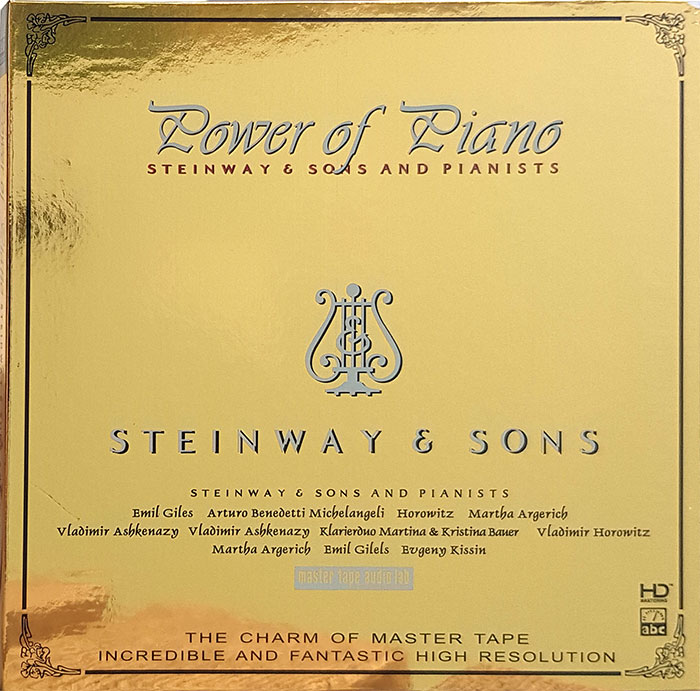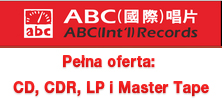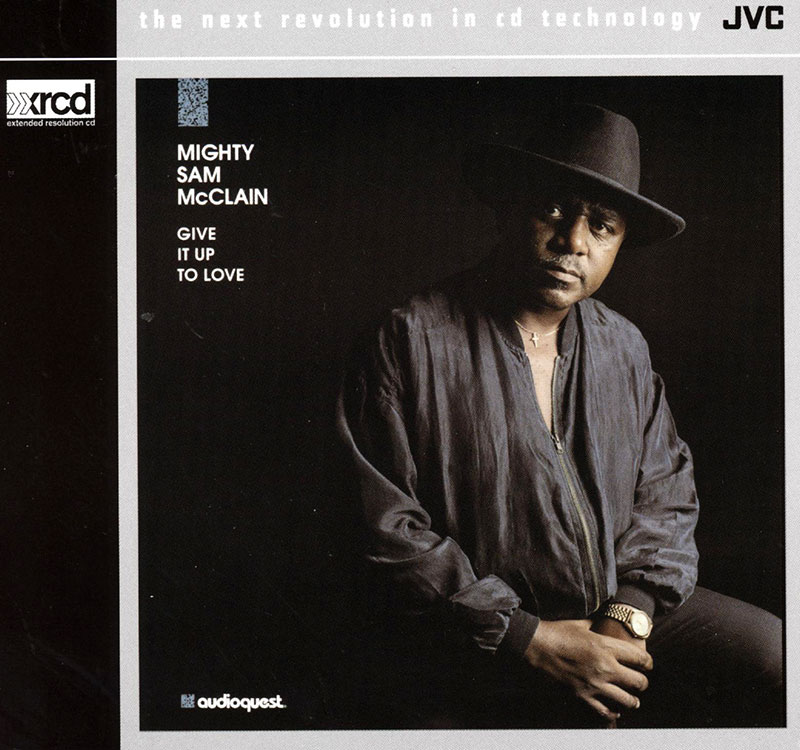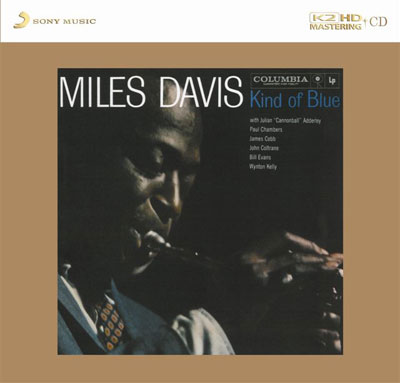Logowanie
Dlaczego wszystkjie inne nie brzmią tak jak te?
Chai Lang, Fan Tao, Broadcasting Chinese Orchestra
Illusive Butterfly
Butterly - motyl - to sekret i tajemnica muzyki chińskiej.
SpeakersCorner - OSTATNIE!!!!
RAVEL, DEBUSSY, Paul Paray, Detroit Symphony Orchestra
Prelude a l'Apres-midi d'un faune / Petite Suite / Valses nobles et sentimentales / Le Tombeau de Couperin
Samozapłon gwarantowany - Himalaje sztuki audiofilskiej
PROKOFIEV, Stanislaw Skrowaczewski, Minneapolis Symphony Orchestra
Romeo and Juliet
Stanisław Skrowaczewski,
✟ 22-02-2017
BARTOK, Antal Dorati, Philharmonia Hungarica
Dance Suite / Two Portraits / Two Excerpts From 'Mikrokosmos'
Samozapłon gwarantowany - Himalaje sztuki audiofilskiej
ENESCU, LISZT, Antal Dorati, The London Symphony Orchestra
Two Roumanian Rhapsodies / Hungarian Rhapsody Nos. 2 & 3
Samozapłon gwarantowany - Himalaje sztuki audiofilskiej
Winylowy niezbędnik
ClearAudio
Cartridge Alignment Gauge - uniwersalny przyrząd do ustawiania geometrii wkładki i ramienia
Jedyny na rynku, tak wszechstronny i właściwy do każdego typu gramofonu!
ClearAudio
Harmo-nicer - nie tylko mata gramofonowa
Najlepsze rozwiązania leżą tuż obok
IDEALNA MATA ANTYPOŚLIZGOWA I ANTYWIBRACYJNA.
Wzorcowe
Carmen Gomes
Celebrating the art and spirit of music - vol. 5 - Reference Songs
- CHCECIE TO WIERZCIE, CHCECIE - NIE WIERZCIE, ALE TO NIE JEST ZŁUDZENIE!!!
Petra Rosa, Eddie C.
Celebrating the art and spirit of music - vol. 3 - Pure
warm sophisticated voice...
SAMPLER - STS DIGITAL, Gregor Hamilton
Celebrating the art and spirit of music - vol. 2 - Love songs from Gregor Hamilton
...jak opanować serca bicie?...
SAMPLER - STS DIGITAL
Celebrating the art and spirit of music - vol. 1 - Leonardo Amuedo
Największy romans sopranu z głębokim basem... wiosennym
Lils Mackintosh
Celebrating the art and spirit of music - vol. 4 - A Tribute to Billie Holiday
Uczennica godna swej Mistrzyni
BEETHOVEN, CHOPIN, LISZT, Emil Gilels, Valdimir Horowitz, Evgeny Kissin, Martha Argerich
Power of Piano

- Emil Gilels - piano
- Valdimir Horowitz - piano
- Evgeny Kissin - piano
- Martha Argerich - piano
- BEETHOVEN
- CHOPIN
- LISZT
AAD is a Digital Copy Of The Master Tape
UWAGA!!!
PŁYTA NAGRANA Z PEŁNĄ DYNAMIKĄ DŹWIĘKU! JEJ ODSŁUCH NALEŻY ROZPOCZĄĆ OD MNIEJSZEGO NIŻ ZWYKLE POZIOMU WYSTEROWANIA WZMACNIACZA!
Engelhard Steinway in a Manhattan loft on Varick Street.
Henry was a master cabinet maker who built his first piano in the kitchen of his Seesen, Germany home. By the time Henry established Steinway & Sons, he had built 482 pianos. The first piano produced by the company, number 483, was sold to a New York family for $500. It is now displayed at New York City’s Metropolitan Museum of Art. Over the next forty years, Henry and his sons, Henry Jr., Albert, C.F. Theodore, William, and Charles, developed the modern piano. Almost half of the company’s 114 patented inventions were developed during this period. Many of these late nineteenth-century inventions were based on emerging scientific research, including the acoustical theories of the renowned physicist Hermann von Helmholtz. Steinway’s revolutionary designs and superior workmanship began receiving national recognition almost immediately. Starting in 1855, Steinway pianos received gold medals
at several U.S. and European exhibitions. The company
gained international recognition in 1867 at the Paris Exhibition when it was awarded the prestigious "Grand Gold Medal of Honor" for excellence in manufacturing and engineering. It was the first time an American company had received this award. Steinway pianos quickly became the piano of choice for many members of royalty and won the respect and admiration of the world’s great pianists.
In 1866 Steinway & Sons opened the first Steinway Hall on 14th Street. With a main auditorium of 2,000 seats, it became New York City’s artistic and cultural center, housing the New York Philharmonic until Carnegie Hall opened in 1891. By this time, the company had moved to its current location in the Astoria section of Queens, New York, and built Steinway Village. Virtually its own town, Steinway Village had its own foundries, factory, post office, parks and housing for employees. In 1871, Henry Sr. died and sons C.F. Theodore and William took over operations. An accomplished pianist, C.F. Theodore was responsible for the technical aspects of piano making and personally earned the company 41 patents, including one in 1875 for the modern concert grand piano. In the same year, William helped establish a showroom in London. Five years later, in 1880,
the Hamburg factory began operating and a retail
operation, the Steinway-Haus, was established.
Another retail operation opened in Berlin in 1909.
Today, Steinway & Sons crafts approximately 5,000
pianos a year worldwide. Over 1300 prominent concert artists and ensembles across the world bear the title Steinway Artist. No artist or ensemble is a paid endorser of the piano. Each Steinway Artist personally owns a Steinway and has chosen to perform on the Steinway piano professionally. In North America, artists select their Steinway for concert performances from the
company’s unique "piano bank," an inventory of more than 300 pianos valued at over $15 million. Pianos are placed throughout North America and are maintained to concert standards by an exclusive network of Steinway dealers. The famed "basement" of
New York’s Steinway Hall, at 109 West 57th Street in
New York City, is the bank’s home office. Branch piano banks are maintained at Steinway dealerships in cities throughout the country to serve performing artists. In all other countries, major concert venues in each town own Steinway & Sons instruments which the artist can use.
 Zapraszamy
Zapraszamy
fachowcy od dźwięku doskonałego. Co kilka miesięcy burzą nasze wyobrażenia o granicy możliwości technicznych w rejestrowaniu bezstratnym muzyki i dźwięków naszej rzeczywistości.
Dziś taką nowością doskonałą, jest technologia opracowana w firmie ABC Int’l Records. Podstawą są nośniki wyprodukowane z wykorzystaniem materiałów ciekłokrystalicznych. To w odniesieniu do krążków CD. Ale podstawą jest, była i będzie – taśma magnetyczna, najlepszy ze znanych nośników zapisu analogowego. Tylko taśma pozwala na niemal doskonałe odwzorowanie zapisanych dźwięków z wiernością porównywalną z walorami tonów źródłowych.
Nie super cyfrowa produkcja, nie doskonale tłoczony winyl – tylko taśma!
W ABC Int’l Records magnetofon STUDER A80 odczytuje zapis z taśmy. Powstaje kopia AAD. Cyfrowa kopia źródła analogowego. Ten trafia do HHB CDR-830 – profesjonalnego duplikatora płyt CD-R - AAD Digital CD. Innymi słowy – otrzymujemy dysk, z którego zazwyczaj robi się matrycę do tłoczenia milionów kopii konsumenckich CD. Tych, które obarczone są wszystkimi błędami kolejnych etapów produkcji tejże płyty. Zamiast źródlanej – woda przegotowana, w najlepszym przypadku!
Płyty AAD Digital CD 1:1 są więc cyfrowymi kopiami taśmy-matki. Wolnymi od jakichkolwiek procesów edycyjnych, poprawczych czy uszlachetniających. Dostajemy do ręki to, co artysta wykonał w studiu lub na koncercie, technik zapisał na taśmie, a obaj, po odsłuchu materiału w wozie transmisyjnym czy studiu nagraniowym orzekli: tak, to nasza muzyka, nasza realizacja, dokładnie tak graliśmy, jak nasz kolega utrwalił na taśmie.
Wreszcie CD High Damping Coating. Technologia w ogólnym ujęciu znana od ćwierćwiecza, nieustanie doskonalona, wykorzystująca materiały o idealnej przejrzystości, a więc ciekłokrystaliczne. W płytach oferowanych przez ABC – zastosowano dodatkowo powłokę tłumiącą wszelkie fizyczne i elektroniczne, niepotrzebne artefakty. Po prostu – otrzymujemy – kopię taśmy-matki na płycie CD o rewelacyjnych walorach dźwiękowych w porównaniu z krążkami bazującymi na tworzywie poliwęglanowym.
****
I znów zatoczyliśmy kolejny krąg.
Co było odrzucone i sponiewierane (winyl, teraz taśma) - wraca w glorii i chwale.
I tylko ironia losu polega na tym, że ofiary naszej głupoty napędzanej cywilizacyjną próżnością, jak biblijny Józef, miast skarcić braci za sprzedanie go, nagradza nas znów pięknym dźwiękiem, wiernością przekazu, naturalnością brzmienia.




























